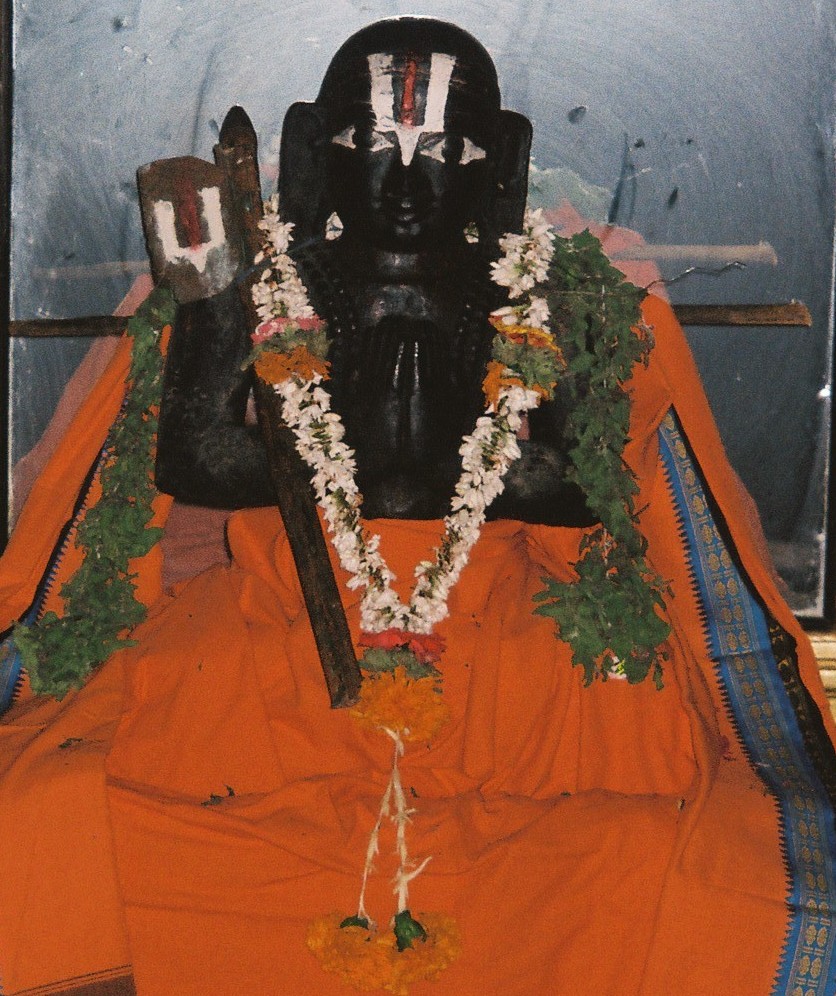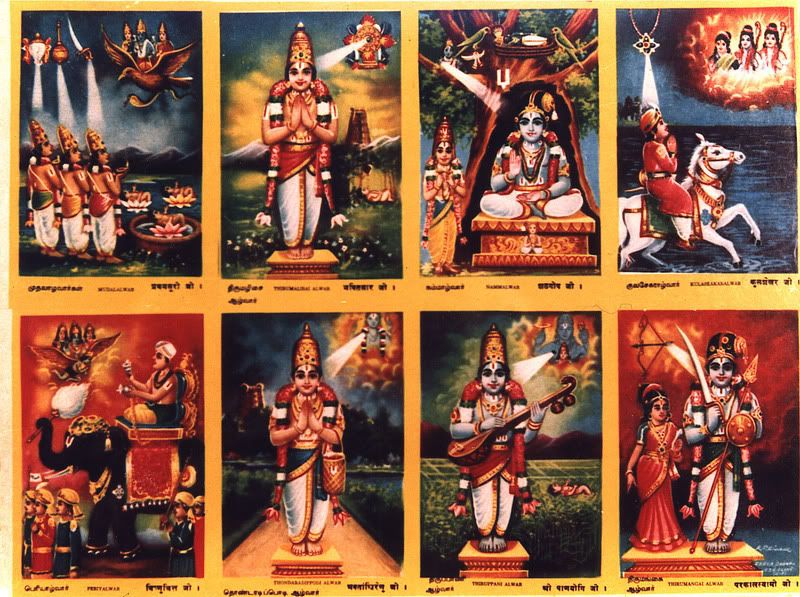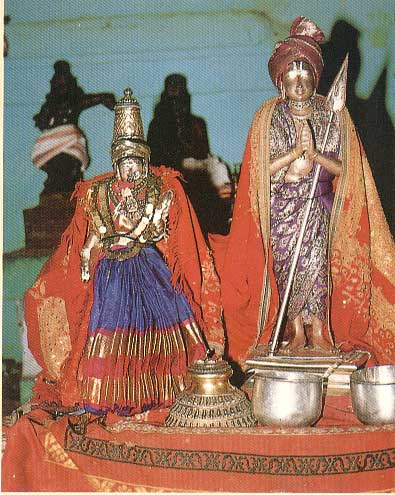English translation (thanks- http://sriramanujar.tripod.com/): "I take refuge at the feet of our guru Bhagavaan Ramanuja, that ocean of mercy who, infatuated with the gold-like, lotus feet of the Lord, considered all else as mere blades of grass."yo nityaM acyuta-padAmbuja-yugma-rukmavyAmohatas tad itarANi tRNAya mene |rAmAnujasya caraNau sharaNam prapadye ||
asmad guror bhagavato 'sya dayaika-sindhoH
Ramanujacharya's image in a Temple
Srimad Ramanujacharya has produced a remarkable commentary on the Bhagavad Gita for the benefit of this world. Before him, his grand-guru Yamunacharya (Sanskrit: yAmunAcArya, Tamil: ALavandAr) produced a terse metrical exposition on the essence of the Bhagavad Gita, dedicating one verse to each chapter of the Gita, known as gItArtha sa"ngraH. Sri Vedanta Desika Acharya (a.k.a ve"nkaTanAtha), who lived a little more than a century after Sri Ramanuja, has produced an elaborate sub-commentary known as tAtparya candrika, upholding the spiritual lineage.
We will now look at how the great acharya of the Srivaishnava tradition, Sri Ramanuja, has attested to the Lord's attributes of Transcendence (paratvam), Immanence (antaryAmitvam), and Creator-hood (jagatkAraNatvam) that we saw in the second and the third posts using Sri Ramanujacharya's commentary to the Bhagavad Gita. Thankfully, there is a good English translation of the same available on the web, and I am depending on the same [1]. Elaborating on verse 5 of Chapter 9 in the Gita, Sri Ramanujacharya writes:
"Lord Hari says: 'I do not support the beings as a jug or any kind of vessel supports the water contained in them. How then are the beings contained in Me? By My will. Behold My divine Yoga power, namely, My wonderful divine modes, unique to Me alone and having no comparison elsewhere'. What are these modes? 'I am the upholder of all beings and yet I am not in them --- My will sustains all beings.' The meaning is, 'I am the supporter of all beings, and yet I derive no help for Myself whatever from them. My will alone projects, sustains and controls all beings.' "
(Ramanuja's bhagavad-gItA-bhASya, 9.5)
The Acharya then says that the Lord is now going to give an illustration to show how all beings depend on His will for their being and acts. To the next verse in the Gita, Sri Ramanuja writes:
"The knowers of the Veda declare thus: 'The origin of clouds, the waters of the ocean remaining within bounds, the phases of the moon, the strong movements of the gale, the flash of lightning and the movements of the sun --- all these are marvelous manifestations of the power of Vishnu.' The meaning is that they are all the marvelous miracles which are unique to Vishnu."
(Ramanuja's bhagavad-gItA-bhASya, 9.6)
He proceeds thus in his commentary to the next verse:
"All the mobile and immobile entities enter into the primordial matter owned by Lord Krishna at the end of a cycle, namely at the end of Brahma's life in accordance with the Lord's will."
(Ramanuja's bhagavad-gItA-bhASya, 9.7)
and then,
"Lord Hari, operating His Prakrti (primordial matter), with its wonderfully variegated potency, develops it eightfold and send forth this fourfold aggregate of beings: the devas, animals, men and inanimate things, time after time."
(Ramanuja's bhagavad-gItA-bhASya, 9.8)
We turn to the natural question - How does our dear Lord Hari work these great miracles without physical effort? Before we investigate, let us learn a little bit more about Sri Ramanujacharya's glorious school.
The Divya Prabandha (divya prabandha) is an anthology of 4000 devotional hymns on Lord Hari in Tamil, written by South Indian saints known as Azhwars (pronounced as AlvArs in our transliteration scheme). Traditionally, the lifetimes of these saints are said to have spanned several thousand years BC till somewhere around the 7th/8th Centuries AD. The works of these twelve poets, rich in devotion, philosophical depth, and universal brotherhood concepts, are celebrated as "Dravida Vedam (drAviDa vedam)" by great scholars of Sri Ramanujacharya's tradition. This is indeed no exaggeration and hence is not to be taken lightly, as the Divya Prabandha works do indeed get into the depths of the philosophy and theology of the Vedas, albeit in poetic Tamil. However, unlike the Sanskrit Vedas, the Divya Prabandhas do not require very strict regulations on chanting, and in fact, can be learned by anyone irrespective of caste, creed, gender, etc.
An illustration of the lives of ten of the twelve Azhwars
The very first successors and disciples of Sri Ramanujacharya include the following Acharyas in the following order: (1) Sri Embar (a.k.a. Govinda Bhattar), the cousin of Sri Ramanujacharya; (2) Sri Parasara Bhattar, the disciple of Sri Embar and the son of Sri Kurattalvan; (3) Sri Nanjeeyar, disciple of Sri Bhattar, and (4) Sri Nampillai, disciple of Sri Nanjeeyar. Sri Nampillai wrote a commentary (known as nampiLLai iiDu in Tamil) on "Thiruvaimozhi (tiru-vAy-moli)", a work of Saint Nammalwar that belongs to the Divya Prabandha.Acharya Nanjeeyar
Sri Nampillai's guru and Sri Parasara Bhattar's disciple, Sri Nanjeeyar, is initially said to have been an advaitin known as mAdhavAcArya, and eventually became the disciple of Sri Parasara Bhattar owing to the latter's brilliant exposition of "Thirunedum-Thandakam" (tiru-neDum-tANDakam) which also belongs to the 4000 Divya Prabandha and is composed by one of the AlvAr saints known as "Thirumangai Azhwar" (tiruma"ngai AlvAr). Thirunedum-Thandakam is a very beautiful composition that combines both "masculine" philosophical exposition and "feminine" devotional adoration in a balanced manner, in one single work. It combines both Vedantic descriptions of Lord Hari as well as the adoration of His form, as he resides in sacred shrines located all over India. In one verse, Saint Tirumangai Azhwar says:
irunilamkAl tInIrviN pUtam aintAy,cen-tiRatta tamizhOsai vaDa-soll-Agitticai nAnkumAyt ti"nkaL ~nAyiRAgi,antarattil-tEvarkkum aRiyal AgA-andaNanai, andaNar mATTu andi-vaitta-mandirattai, mandirattAl maRavAdu enRumvAzhutiyEl vAzhalAm maDa ne~njE!
(Thirunedum-Thandakam 4, Divya Prabandha 2055)
The above verse means: "Hey you foolish mind! If you want to live, live chanting the name of the Lord using the sacred eight-lettered mantra ending with 'namo nArAyaNAya' - the name of the Lord who is (1) The Lord to even great devatas such as the four-faced Brahma and Indra, (2) Who is the inner controller and inner-dweller (antaryAmin) for everything made of the five elements - earth, water, fire, wind, and space, (3) Who pervades all directions, the sun and the moon, (4) Who is very hard to comprehend even for the great devas from Brahma, Indra, etc. (5) Who is praised by the Sanskrit Upanishads and the Tamil Divya Prabandha, (5) Who is the Lord known through the wealth of the learned scholars - the Vedas." Thus, Thirumangai Azhwar is confirming the doctrine of the Lord Narayana being the antaryAmi or the inner-soul and inner-controller of everything in the universe, the Lord of all, and is known through the Vedas and Tamil Divya Prabandha texts.
Since the last post, we have discussed about the marvelous miracles of Lord Madhava (another name of the Supreme Lord Hari).With His unlimited unfathomable power, He creates, sustains, and dissolves the entire universe consisting of all beings. This shows that we are entirely dependent on Him and should thank Him for our existence, prosperity, and enjoyment in this life and the next.
(to be continued)
Bibliography
[1] English Translation of Ramanuja's Gita Bhashya, Dr. S. Sankaranarayanan. (Thanks: Gita Supersite 2.0)
[2] Sudarshanam Editor Sri Puttur Krishnaswami Iyengar's book, "Thirunedum-Thandaka Vivaranam" (திருநெடுந்தாண்டக விவரணம்), Thanks: http://www.maransdog.org
[2] Sudarshanam Editor Sri Puttur Krishnaswami Iyengar's book, "Thirunedum-Thandaka Vivaranam" (திருநெடுந்தாண்டக விவரணம்), Thanks: http://www.maransdog.org





Nice post!
ReplyDeleteSri Ramanujar revived Vaishnavism in the South at a time when people were drifting towards newly-emerging faiths like Buddhism.
He left behind a rich traditioN, which encompassed in its fray, and gave the highest importance to 4000 divya prabandham, thanks to which, it is still followed in temples today.
Dear In Love With Krishna,
ReplyDeleteI thank you very much for your appreciation! All credit go to Perumal, Azhvars, Acharyas, and my bhAgavata bandhus such as you.
Adiyen,
Prahlada-dAsan